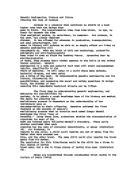Genetic Engineering is a modern science where the genes of an organism are changed to alter the features of that organism.
Alastair Baillie Biology Coursework:
The moral and ethical issues associated
with recombinant DNA technology
Genetic Engineering is a modern science where the genes of an organism are changed to alter the features of that organism. This normally happens by the extraction of genes from one organism, and these genes are then introduced into another organism to aid it in survival. Genes are removed from the DNA (deoxyribose nucleic acid) of an organism, and each gene codes for a particular trait in that organism (e.g. eye colour). Now that scientists have discovered what traits many of these genes code for, both in plants and in animals, they can modify these genes to benefit other organisms. For example, if a patient has a gene disorder, such as sickle cell anaemia, scientist can now obtain the correct gene and insert it into the patient to help them. There have been many questions about whether genetic engineering is ethical or safe but another questions is this; are there too many benefits to just ignore genetic engineering?
(10, 7) (1, 2)
Agriculture is probably one of the most beneficial forms of genetic engineering, and is also the most commonly used. It is now possible for scientists to modify plants so that they are able to grow in unfavourable environments; places where there are extreme climates. At the moment, researchers are experimenting on the ability to enable plants to survive frosts, whereas other plants are being genetically modified to help them fight against diseases. There are two good examples of this process in action. Firstly the tomato; if a tomato is given a fungal-fighting microbe, it can resist the grey mould called botrytis. The other is the fact that rice, in normal circumstances, does not contain very much vitamin A. In the poorer parts of Asia, where rice is almost the only food of the rural population, a vitamin A deficiency is common, leading to early blindness. Scientists are creating a strain of rice, which is rich in vitamin A -- the amount of rice in a typical third world diet could provide about fifteen percent of the recommended daily allowance of vitamin A, sufficient to prevent blindness. Now that a few plants with this trait have been created, they are being cross bred with other varieties of rice using conventional breeding techniques, as has been done for centuries. Such cross breeding could further increase the vitamin A content. Genetic engineers also intend to produce a rice variety rich in iron, because iron-deficiency anaemia is a common problem in the same rural populations. But this is a more difficult problem than increasing rice's vitamin A content. Rice contains an enzyme called phytase. Phytase prevents the body from absorbing iron, so it does little good to breed for increased iron content, and the rice plant cannot reproduce without adequate phytase in the grains. Scientists hope to be able to find a gene coding for a protein that will break down phytase when the rice is cooked. (10, 7, 11) (1, 2, 3)







